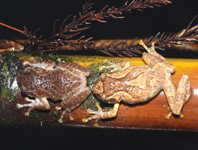Abstract
plants, are mostly unknown. All known immature stages of Merodon feed on underground storage organs (bulbs, rhizomes and corms) of geophytes of the families Asparagaceae, Iridaceae and Amaryllidaceae. Of 160 known Merodon species, to date, the pupal stages have been described for only four: M. equestris (Fabricius), M. bombiformis Hull, M. luteihumerus Marcos-García, Vujić & Mengual, and M. geniculatus Strobl. During field investigations in Đerdap National Park, Serbia, Merodon puparia were found in the ground near the bulbs of Ornithogalum umbellatum L. (Asparagaceae). DNA barcoding revealed that they belonged to the species M. aureus Fabricius and M. avidus (Rossi). Analysis of museum material from the Bavarian State Collection of Zoology in Germany revealed the puparium of an additional species, M. rufus Meigen. In our study we provide for the first time descriptions of the puparia of these three Merodon species. The main diagnostic morphological characters of the pupal spiracles and posterior respiratory processes are described using scanning electron microscopy, and cephalopharyngeal skeletons using binocular microscopy. In addition, puparium morphology of M. aureus, M. avidus and M. rufus is compared with known puparia of four other Merodon species and with the third larval stage of M. hurkmansi Marcos-García, Vujić & Mengual.
References
Andrić, A., Šikoparija, B., Obreht, D., Đan, M., Preradović, J., Radenković, S., Pérez-Bañón, C. & Vujić, A. (2014) DNA barcoding applied: identification of the larva of Merodon avidus (Diptera: Syrphidae). Acta Entomologica Musei Nationalis Pragae, 54 (2), 741–757.
Chen, H., Rangasamy, M., Tan, S.Y., Wang, H. & Siegfried, B.D. (2010) Evaluation of five methods for total DNA extraction from western corn rootworm beetles. PLoS ONE, 5 (8), e11963, 1–6.
https://doi.org/10.1371/journal.pone.0011963Dumbardon-Martial, E. (2016) Pollen feeding in the larva of Toxomerus pulchellus (Diptera, Syrphidae). Bulletin de la Société entomologique de France, 121 (4), 413–420.
Folmer, O., Black, M., Hoeh, W., Lutz, R. & Vrijenhoek, R. (1994) DNA primers for amplification of mitochondrial cytochrome c oxidase subunit I from diverse metazoan invertebrates. Molecular Marine Biology and Biotechnology, 3 (5), 294–299.
Heiss, E.M. (1938) A classification of the larvae and puparia of the Syrphidae of Illinois exclusive of aquatic forms. Illinois Biological Monographs, 16 (4), 1–142.
https://doi.org/10.5962/bhl.title.50277Hodson, W.E.H. (1932) The large narcissus fly, Merodon equestris, Fab. (Syrphidae). Bulletin of Entomological Research, 23, 429–448.
https://doi.org/10.1017/S0007485300004259Hurkmans, W. (1988) Ethology and ecology of Merodon in Turkey (Diptera: Syrphidae). Entomologische Berichten (Amsterdam), 48 (7), 107–114.
Hurkmans, W. (1993) A monograph of Merodon (Diptera: Syrphidae). Part 1. Tijdschrift Voor Entomologie, 136, 147–234.
Pehlivan, E. & Akbulut, N. (1991) Some investigations on the syrphid species attacking on Narcissus in Karaburun (Izmir) and the biology and control measures of Merodon eques (F.) (Diptera). Turkish Journal of Agriculture and Forestry, 15, 47–81.
Pérez-Bañón, C., Hurtado, P., García-Gras, E. & Rojo, S. (2013) SEM Studies on Immature Stages of the Drone Flies (Diptera, Syrphidae): Eristalis similis (Fallen, 1817) and Eristalis tenax (Linnaeus, 1758). Microscopy Research and Technique, 76 (8), 853–861.
https://doi.org/10.1002/jemt.22239Peterson, A., Bartish, I.V. & Peterson, J. (2008) Effects of population size on genetic diversity, fitness and pollinator community composition in fragmented populations of Anthericum liliago L. Plant Ecology, 198 (1), 101–110.
https://doi.org/10.1007/s11258-007-9388-4Popov, G.V. (2001) What and where are Merodon feeding? In: First international workshop on the Syrphidae. Staatliches Museum für Naturkunde, Stuttgart, Germany, pp. 28–29.
Popov, G.V. (2010) Merodon alexandri spec. nov.—a new species of hoverfly (Diptera: Syrphidae) from the northen Black Sea Region. Studia Dipterologica, 16, 133–151.
Reemer, M. & Goudsmits, K. (2004) Oviposition observed in Chrysotoxum cautum, C. vernale and Merodon avidus (Diptera, Syrphidae). Volucella, 7, 217–218.
Ricarte, A., Marcos-García, M.A. & Rotheray, G.E. (2008) The early stages and life histories of three Eumerus and two Merodon species (Diptera: Syrphidae) from the Mediterranean region. Entomologica Fennica, 19, 129–141.
Ricarte, A., Souba-Dols, G.J., Hauser, M. & Marcos-García, M.A. (2017) A review of the early stages and host plants of the genera Eumerus and Merodon (Diptera: Syrphidae), with new data on four species. PLoS ONE, 12 (12), e0189852, 1–22.
https://doi.org/10.1371/journal.pone.0189852Rotheray, G.E. (1993) Color guide to hoverfly larvae (Diptera, Syrphidae) in Britain and Europe. Dipterist Digest, 9, 1–156.
Rotheray, G.E. & Gilbert, F.S. (1999) Phylogeny of Palaearctic Syrphidae (Diptera): evidence from larval stages. Zoological Journal of the Linnean Society, 127 (1), 1–112.
https://doi.org/10.1006/zjls.1998.0156Rotheray, G.E., Dussaix, C., Marcos-García, M.A. & Pérez-Bañón, C. (2006) The early stages of three Palaearctic species of saproxylic hoverflies (Syrphidae, Diptera). Micron, 37 (1), 73–80.
https://doi.org/10.1016/j.micron.2005.05.003Rotheray, G.E. & Gilbert, F.S. (2011) The Natural History of Hoverflies. Forrest text, UK, 334 pp.
Speight, M.C.D. (2017) Species accounts of European Syrphidae, 2017. In: Syrph the Net, the database of European Syrphidae (Diptera). Vol. 97. Syrph the Net publications, Dublin, pp. 1–294.
Ståhls, G., Vujić, A., Pérez-Bañón, C., Radenković, S., Rojo, S. & Petanidou, T. (2009) COI barcodes for identification of Merodon hoverflies (Diptera, Syrphidae) of Lesvos Island, Greece. Molecular Ecology Resources, 9 (6), 1431–1438.
https://doi.org/10.1111/j.1755-0998.2009.02592.xStepanenko, O.V. & Popov, G.V. (1997) On the immature stages biology of Merodon nigritarsis Rondani, 1845 (Diptera: Syrphidae). The Kharkov Entomological Society Gazette, 5 (2), 40–43.
Stuckenberg, B.R. (1956) The immature stages of Merodon bombiformis Hull, a potential pest of bulbs in South Africa. Journal of Entomological Society of South Africa, 19 (2), 219–224.
Vujić, A., Radenković, S., Ačanski, J., Grković, A., Taylor, M., Şenol, S.G. & Hayat, R. (2015) Revision of the species of the Merodon nanus group (Diptera: Syrphidae) including three new species. Zootaxa, 4006 (3), 439–462.
https://doi.org/10.11646/zootaxa.4006.3.2Weng, J.L. & Rotheray, G.E. (2008) Another non-predaceous syrphine flower fly (Diptera: Syrphidae): pollen feeding in the larva of Allograpta micrura. Studia dipterologica, 15, 245–258.

